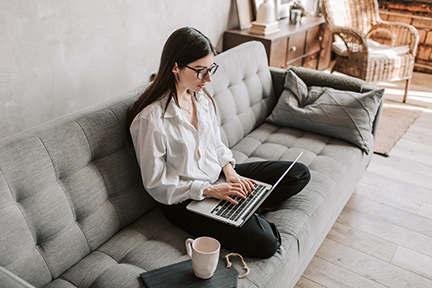Is working from home a pain in the neck?
May 7, 2020

According to Flexjobs.com, in 2020 (before the arrival of COVID-19) there were already seven million people working remotely in the U.S., or 3.4 percent of the population. We all know with the stay-at-home order in place since March, these numbers have grown exponentially.
A functional workspace is critical to successful remote work. Anita Stehmeier, a physical therapist and ergonomic consultant at Northwest Community Healthcare, has been studying ergonomics for more than 25 years and is passionate about injury prevention.
Stehmeier says you don’t need special furniture or equipment to have a safe workspace. “Creating a comfortable work surface on a dining table is achievable, but you may need a footrest, foot stool or even an old textbook to place your feet on to give relief to your hamstrings,” she says. “The height of the table should align with your elbows. The most important thing is to not lean on our arms. Elbows should be at our side, at a 90-degree angle, with wrists flat.”
So many people think curling up on the couch is a cozy way to work. But Stehmeier says, “I discourage sitting on the couch with the laptop on one’s legs. When we sit this way we tend to sit in a ‘C’ posture, which is stressful on the discs in our back.”
Stehmeier goes on to explain a common way of sitting in a chair that can cause problems. “When our feet are not flat on the floor, we scoot forward in the chair to get our feet on the ground, then our knees are lower than our hips, which pitches us forward. Now we are looking for support, so we lean on our arms, creating a ‘forward head’ posture,” she adds, explaining that the position can result in neck and shoulder pain. “Sitting back supported in the chair with feet on footrests off-loads the arms and reduces the stress.”
In recent years we have seen the increase of popularity of standing desks. Stehmeier corrects the rumor that it can help you lose weight. “It’s not aerobic and therefore does not contribute to weight loss,” she explains. “However, being able to alternate positions can be beneficial. But standing all day is also stressful. Putting one foot up on a footrest or stool when standing can reduce back stress, and switching feet allows for each leg to have a rest period.”
You might also have noticed that when working from home you tend to sit more. No walking to a conference room for a meeting or walking from the parking lot to your office. She recommends setting a timer for a stretch break with two to three repetitions each hour. If you begin to feel pain, getting up and moving every 20 minutes is best.
Another aspect of working from home is you might be using a laptop more than a traditional desktop. Sometimes our eyewear/screen interaction can cause physical stress. Stehmeier recommends, “the general rule is that the top of the desktop screen should be at eye level, but if someone has bifocals or trifocals, the screen may need to be lower. Laptops are not the best because the screen is too low, especially if the laptop is actually sitting on the lap. Elevate the laptop on 3-ring binders or a laptop stand to help achieve better alignment with your eyes.”
Pay attention to your homeschooled children and their workspaces too. Although children tend to be physically more flexible and adaptable than the older generations, developing the habits of proper posture in their workspace can only be a benefit for their future.
Since no one yet knows when everyone will be returning to their offices, paying some extra attention to how to safely work from home can prevent unnecessary pain and will be important tools to take back to the office with you.